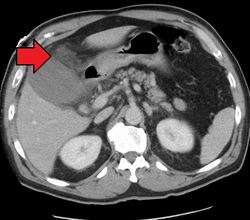Cholecystitis

Editor-In-Chief: Prab R Tumpati, MD
Obesity, Sleep & Internal medicine
Founder, WikiMD Wellnesspedia &
W8MD medical weight loss NYC and sleep center NYC
| Cholecystitis | |
|---|---|

| |
| Synonyms | N/A |
| Pronounce | N/A |
| Specialty | N/A |
| Symptoms | Right upper quadrant pain, fever, nausea, vomiting |
| Complications | Gangrene, perforation, peritonitis, sepsis |
| Onset | Sudden |
| Duration | Hours to days |
| Types | N/A |
| Causes | Gallstones, bile duct obstruction |
| Risks | Obesity, pregnancy, rapid weight loss, diabetes |
| Diagnosis | Ultrasound, CT scan, HIDA scan |
| Differential diagnosis | Peptic ulcer disease, pancreatitis, hepatitis |
| Prevention | N/A |
| Treatment | Cholecystectomy, antibiotics, pain management |
| Medication | Analgesics, antibiotics |
| Prognosis | Generally good with treatment |
| Frequency | Common |
| Deaths | Rare with treatment |
Cholecystitis[edit]

Inflammation of the gallbladder, typically causing fever, nausea, and often severe abdominal pain. Depending on the presentation, it can be considered acute or chronic cholecystitis.

Causes[edit]
Acute cholecystitis occurs when bile becomes trapped in the gallbladder due to a blockage in the bile ducts. Some of the causes for this include gallstone which can get dislodged from the gallbladder and block the cystic duct leading to backup of the bile. When a stone blocks this duct, bile builds up, causing irritation and pressure in the gallbladder which in turn can lead to swelling and infection.
- Gallstones
- Serious illnesses, such as HIV or diabetes
- Tumors of the gallbladder which are generally considered rare.
Some people are more at risk for gallstones as noted below. Chronic cholecystitis

- Most of the time, chronic cholecystitis is caused by repeated attacks of acute (sudden) cholecystitis.
- Most of these attacks are caused by gallstones in the gallbladder.
- These attacks cause the walls of the gallbladder to thicken.
- The gallbladder begins to shrink. Over time, the gallbladder is less able to concentrate, store, and release bile.
- The disease occurs more often in women than in men.
- It is more common after age 40. Birth control pills and pregnancy are factors that increase the risk for gallstones.
Risk factors[edit]
Risk factors include:
- Being female
- Pregnancy
- Hormone therapy
- Older age
- Being Native American or Hispanic
- Obesity
- Losing or gaining weight rapidly
- Diabetes

- Sometimes, the bile duct becomes blocked temporarily when it is called acute cholecystitis.
- When this occurs repeatedly, it can lead to long-term or chronic cholecystitis.
- This is swelling and irritation that continues over time.
- Eventually, the gallbladder becomes thick and hard.
It does not store and release bile as well as it did.
Management[edit]
A thorough history and physical examination should be obtained including prior history of similar episodes, food intake, especially recent intake of fatty foods. Enquire about the nature of the pain, severity, and any radiation to the right shoulder which can happen with cholecystitis. During the physical examination, palpate the abdomen for tenderness, rigidity, rebound tenderness, and also elicit Murphy's sign.

Blood tests include:
- Amylase and lipase
- Bilirubin
- Complete blood count (CBC)
- Liver function tests
Imaging studies
- Abdominal ultrasound
- Abdominal CT scan or MRI scan
- Abdominal x-ray
- Oral cholecystogram
- Gallbladder radionuclide scan
Treatment[edit]
- If you have severe belly pain, seek medical attention right away.
- In the emergency room, you may be given fluids through a vein.
- You also may be given antibiotics to fight infection.
- Cholecystitis may clear up on its own.

Surgery[edit]
If you have gallstones leading cholecystitis, especially of it happens repeatedly, you will probably need surgery to remove your gallbladder. Nonsurgical treatment includes:
- Antibiotics you take at home to fight infection
- Low-fat diet (if you are able to eat)
- Pain medicines
- You may need emergency surgery if you have complications such as:
- Gangrene (tissue death) of the gallbladder
- Perforation (a hole that forms in the wall of the gallbladder)
- Pancreatitis (inflamed pancreas)
- Persistent bile duct blockage
- Inflammation of the common bile duct

If you are very ill, a tube may be placed through your belly into your gallbladder to drain it. Once you feel better, your provider may recommend that you have surgery.
Prognosis[edit]
Most people who have surgery to remove their gallbladder recover completely.
Possible Complications[edit]
- Untreated, cholecystitis may lead to any of the following health problems:
- Empyema (pus in the gallbladder)
- Gangrene
- Injury to the bile ducts draining the liver (may occur after gallbladder surgery)
- Pancreatitis
- Perforation
- Peritonitis (inflammation of the lining of the abdomen)
Prevention[edit]
Reducing fatty food intake and removal of gallbladder can prevent further attacks
|
|
|
| Health science - Medicine - Gastroenterology - edit |
|---|
| Diseases of the esophagus - stomach |
| Halitosis | Nausea | Vomiting | GERD | Achalasia | Esophageal cancer | Esophageal varices | Peptic ulcer | Abdominal pain | Stomach cancer | Functional dyspepsia | Gastroparesis |
| Diseases of the liver - pancreas - gallbladder - biliary tree |
| Hepatitis | Cirrhosis | NASH | PBC | PSC | Budd-Chiari | Hepatocellular carcinoma | Acute pancreatitis | Chronic pancreatitis | Pancreatic cancer | Gallstones | Cholecystitis |
| Diseases of the small intestine |
| Peptic ulcer | Intussusception | Malabsorption (e.g. Coeliac, lactose intolerance, fructose malabsorption, Whipple's) | Lymphoma |
| Diseases of the colon |
| Diarrhea | Appendicitis | Diverticulitis | Diverticulosis | IBD (Crohn's, Ulcerative colitis) | IBS | Constipation | Colorectal cancer | Hirschsprung's | Pseudomembranous colitis |
Ad. Transform your life with W8MD's Budget GLP-1 injections from $75


W8MD offers a medical weight loss program to lose weight in Philadelphia. Our physician-supervised medical weight loss provides:
- Weight loss injections in NYC (generic and brand names):
- Zepbound / Mounjaro, Wegovy / Ozempic, Saxenda
- Most insurances accepted or discounted self-pay rates. We will obtain insurance prior authorizations if needed.
- Generic GLP1 weight loss injections from $75 for the starting dose.
- Also offer prescription weight loss medications including Phentermine, Qsymia, Diethylpropion, Contrave etc.
NYC weight loss doctor appointmentsNYC weight loss doctor appointments
Start your NYC weight loss journey today at our NYC medical weight loss and Philadelphia medical weight loss clinics.
- Call 718-946-5500 to lose weight in NYC or for medical weight loss in Philadelphia 215-676-2334.
- Tags:NYC medical weight loss, Philadelphia lose weight Zepbound NYC, Budget GLP1 weight loss injections, Wegovy Philadelphia, Wegovy NYC, Philadelphia medical weight loss, Brookly weight loss and Wegovy NYC
|
WikiMD's Wellness Encyclopedia |
| Let Food Be Thy Medicine Medicine Thy Food - Hippocrates |
Medical Disclaimer: WikiMD is not a substitute for professional medical advice. The information on WikiMD is provided as an information resource only, may be incorrect, outdated or misleading, and is not to be used or relied on for any diagnostic or treatment purposes. Please consult your health care provider before making any healthcare decisions or for guidance about a specific medical condition. WikiMD expressly disclaims responsibility, and shall have no liability, for any damages, loss, injury, or liability whatsoever suffered as a result of your reliance on the information contained in this site. By visiting this site you agree to the foregoing terms and conditions, which may from time to time be changed or supplemented by WikiMD. If you do not agree to the foregoing terms and conditions, you should not enter or use this site. See full disclaimer.
Credits:Most images are courtesy of Wikimedia commons, and templates, categories Wikipedia, licensed under CC BY SA or similar.
Translate this page: - East Asian
中文,
日本,
한국어,
South Asian
हिन्दी,
தமிழ்,
తెలుగు,
Urdu,
ಕನ್ನಡ,
Southeast Asian
Indonesian,
Vietnamese,
Thai,
မြန်မာဘာသာ,
বাংলা
European
español,
Deutsch,
français,
Greek,
português do Brasil,
polski,
română,
русский,
Nederlands,
norsk,
svenska,
suomi,
Italian
Middle Eastern & African
عربى,
Turkish,
Persian,
Hebrew,
Afrikaans,
isiZulu,
Kiswahili,
Other
Bulgarian,
Hungarian,
Czech,
Swedish,
മലയാളം,
मराठी,
ਪੰਜਾਬੀ,
ગુજરાતી,
Portuguese,
Ukrainian


